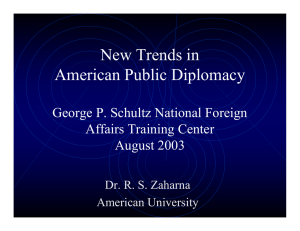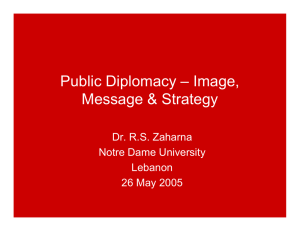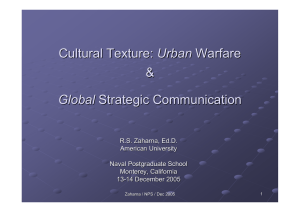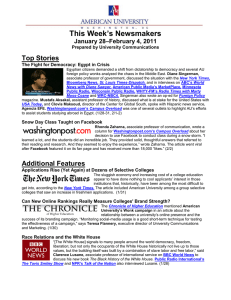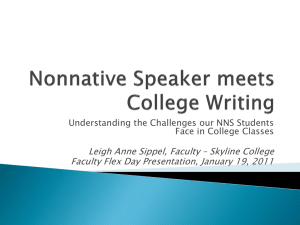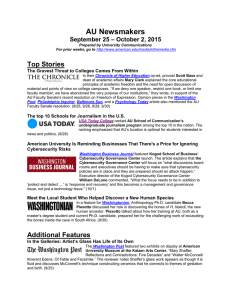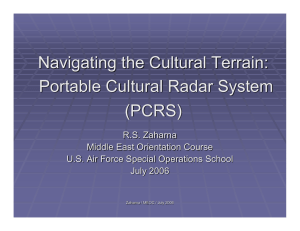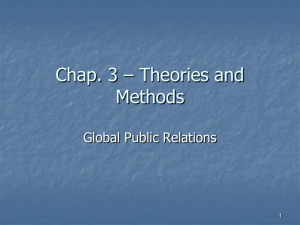The Challenge to Effective American Public Diplomacy Dr. R.S. Zaharna American University
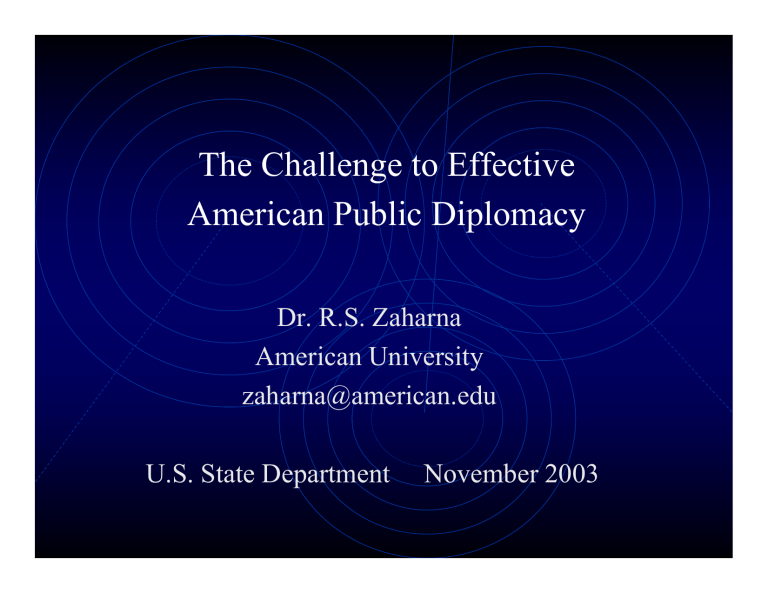
The Challenge to Effective
American Public Diplomacy
Dr. R.S. Zaharna
American University zaharna@american.edu
U.S. State Department November 2003
Public Communication Hurdles
• Attention
• Comprehension
• Retention
• Action
Zaharna / November 2003 2
Comprehension Problem
What America thinks is being communicated is not what the Arab public understands.
Zaharna / November 2003 3
Getting over the
Comprehension Hurdle
• Think of public diplomacy as a process as well as a product
• Think of public diplomacy as an intercultural communication process
• Think of the cultural barriers
• Think of multicultural strategies
Zaharna / November 2003 4
Intercultural Communication Process
It’s not just about cultural differences – it’s how the differences interact
Zaharna / November 2003 5
Why cultural sensitivity important
When you violate a cultural norm through cultural insensitivity you can trigger defense mechanisms in others – they may try to reassert their values more forcefully, or attack and discredit yours.
Zaharna / November 2003 6
American – Communication is . . .
• Communication = Information
• Problem: don’t have or don’t understand information
• Solution: more or better information
• Agency: advanced technology
• Complaint: information overload
Zaharna / November 2003 7
American – Approach
•
Preferred Channel = Mass media
•
Efficient
•
Credible
•
Familiar
Zaharna / November 2003 8
American – Strategy
Focus = Message
Create idea
Produce appealing format
Disseminate efficiently
Zaharna / November 2003 9
Arab – Communication is . . .
• Communication = Relationships
• Problem: strained or broken relations
• Solution: mend or sever relations
• Agency: mediator, negotiator
• Complaint: relationship overload
Zaharna / November 2003 10
Arab – Approach
• Preferred Channel = Interpersonal
Communication
• Effective
• Credible
• Familiar
Zaharna / November 2003 11
Unshared Assumptions
• Mass media is an effective channel
• Message is culturally neutral
• Message speaks for itself
• Mass media not a credible channel
• Message not culturally neutral
• Audience determine meaning of message
Content is important • Context is important
Zaharna / November 2003 12
Result of Intercultural Comm Process
• Achieved content goal – got the message out
• Neglected context – audience supply meaning and mass media not credible
• Distortion – what America thought it was communicating (message) was not what the Arab public perceived
Zaharna / November 2003 13
Effective Public Diplomacy
an intercultural communication process of overcoming cultural barriers through a multicultural approach
(use multicultural approach to bridge cultural differences)
Zaharna / November 2003 14
Multicultural Approach
• Start with your audience and work backwards to Washington
• Audience = relationship focused
• Washington = information focused
Zaharna / November 2003 15
Getting the information out through relationship-building strategies
¾ multicultural approach = create innovative blend of different cultural styles and preferences
Zaharna / November 2003 16
Types of Relationships
• Professional
• Personal
• Community
• Diplomatic
• Regional / Issue
• Personal
• Community
• (Stephen Bruning & John
Ledingham, Capital University,
Ohio 2000)
Zaharna / November 2003 17
Goals of Relationship Building
• Initiate
• create new relations through outreach, open functions, get to know visits
• Develop
• build or expand existing relations by new projects, networking within circle
• Enhance
• strengthen understanding, commitment, satisfaction
• Maintain
• protect and preserve, demonstrate commitment
Zaharna / November 2003 18
Benefits of Relationship Building
• Better predictor of audience behavior
(than message dissemination)
• Allows proactive approach later
(closer to needs and interest of audience)
• Acts as buffer if crisis occurs
(goodwill bank account)
Zaharna / November 2003 19
SMART -- Relationship Building
• Scan – survey and assess current state of relationship
• Map – construct strategic plan focused on relationships goals and activities
• Act – field test strategic plan and assess initial effectiveness
Zaharna / November 2003 20
SMART -- Relationship Building
• Rollout – implement revised strategic plan
• Track – monitor effect on public’s perceptions and behavior
• (Stephen Bruning & John Ledingham, Capital University, Ohio 2000)
Zaharna / November 2003 21
Relationship Building Mindset
• Focus on two-way / interaction / dialogue
• Add personal / social connection in activity
• Build trust (credible, reliable, stable)
• Find mutual interests & goals (win/win)
• Demonstrate interest & involvement
• Build commitment (continuity)
• Think reciprocity, both are “recipients”
Zaharna / November 2003 22
Relationship Building Opportunities
• Speeches – refer to history, connections, people
• ‘Being’ vs ‘Doing’ Visits
• Communicate interest vs need; not all “selling”
• Pictures, gifts, symbolic tokens
• Highlight contributions, cooperation, ties
• Embassy website – spotlight relationship
• Press breakfasts, individual get-to-know lunches
• Highlight the “who” at functions, press releases
Zaharna / November 2003 23
Mono-cultural vs. Multi-cultural
Approach
• It’s not about how I look (image)
• But, how you look at me (perception)
• It’s not what I say (message)
• But, what you say also (dialogue)
• It’s not what I do separately (action)
• But, what you and I do together (cooperation)
Zaharna / November 2003 24
The Challenge to Effective
American Public Diplomacy:
Distortions of Culture
Dr. Rhonda Zaharna
American University
